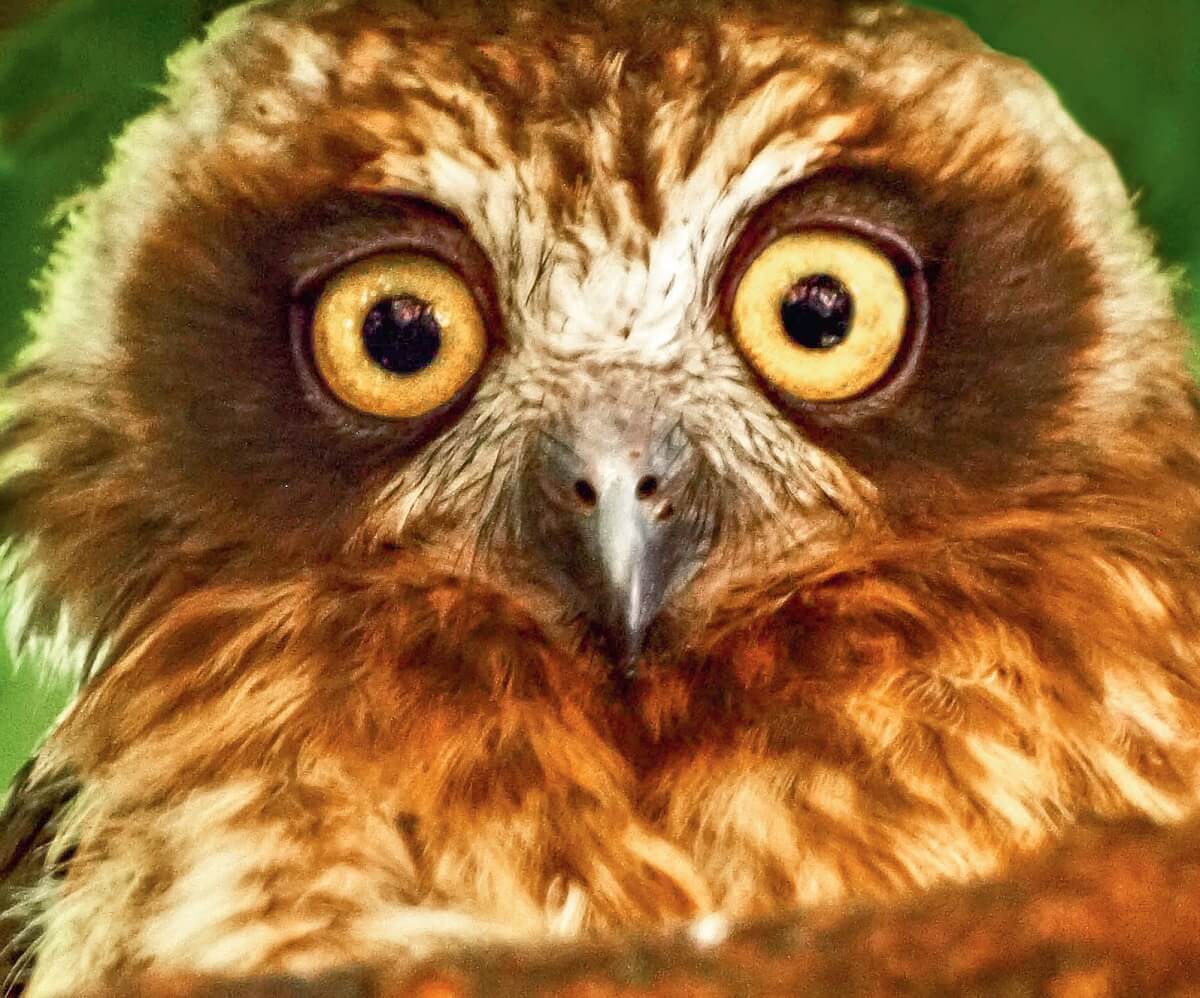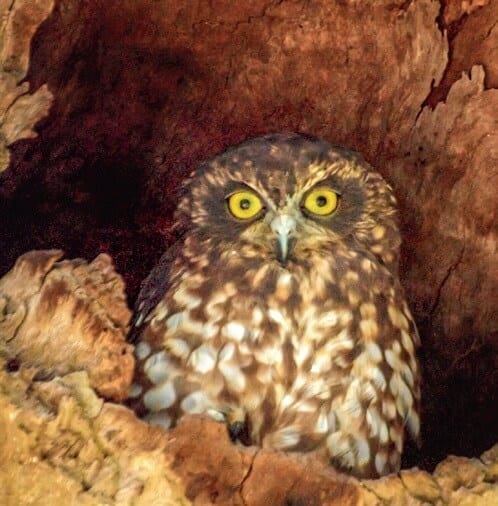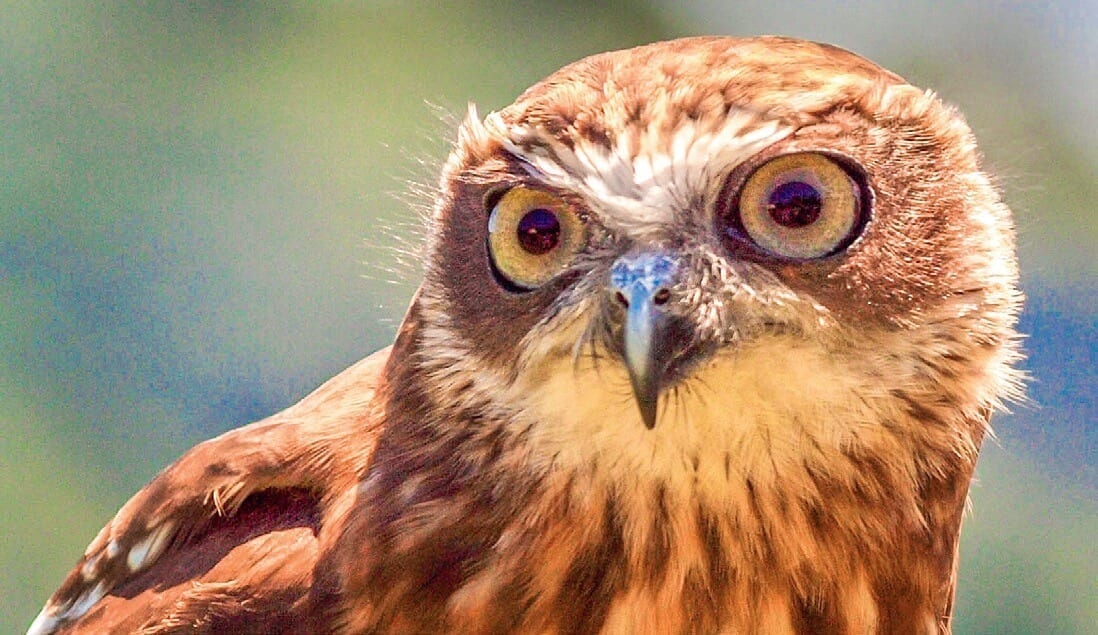Tags: Native Australian Wildlife. Birds. BooBook Owls. Bribie Island. Moreton Bay. Queensland
Australian Boobook Owls are the smallest and most common of the Australian Owls and are reasonably common breeding residents on Bribie Island. They are 30-35 cm in length and weigh 120-350 g. They belong to the Hawk Owl family as their faces are quite hawk-like. Their most prominent feature is their huge yellowish eyes which are surrounded by dark circles.
Featured Image(above): Australian Boobook Owl. Note the Hawk like face
To look in different directions they need to turn their heads as their eyes are fixed in their sockets. Heads are large and tails are short. The plumage is dark brown and mottled with slight variations on birds living in different habitats. Young birds are usually lighter in colour. They are nocturnal birds and their calls “Boobook Boobook” during the night from sunset to sunrise may be heard up to a kilometre away.
Quite often the calls are from a pair of owls calling to each other. Females are a little larger than males. They are thought to live for about 15 years. Occurring singularly, in pairs or in family groups Boobooks may be sighted anywhere in mainland Australia and Tasmania from open woodlands, suburban parks and gardens to the desert. In fact, they may be found anywhere there are suitable trees.
A closely related species is found in NZ, PNG, and Indonesia. During the day they roost in thick foliage usually high up in trees blending in well with the surroundings and therefore very hard to spot. Sometimes the agitated sounds of other birds attacking them are the only indication of their presence. When alarmed they stretch upward and turn side on and try to blend in with their surroundings.

In Mango Tree, Bongaree
Some of their food such as insects and small bats is caught on the wing while other prey such as small mammals and reptiles is pounced upon on the ground. They rely on their sight and hearing for detecting the prey. From a perch on a fence, pole or tree they wait, watching and listening for movement and swiftly pounce when their quarry appears. Their food is swallowed whole and bones etc are later disgorged.
The breeding season is quite long from September to February but most of their breeding is done during October if the conditions are right. Hollows in large old trees, stumps and sometimes in cliff faces are used as nesting sites. Males line the nests with chewed woodchips and leaves. Clutches of 2-3 white eggs are laid and incubated by females for about 34-42 days. Males bring food to the females while on the nest and help with the feeding when the babies hatch.
Chicks are blind and helpless and covered in white down when hatched. After about 6 days the eyes open. Males bring food to the females that tear it apart to feed to the chicks. By this time the nests are becoming quite smelly with the droppings and unwanted food. The young fledge after about 5 weeks and remain under their parents care for several more months before dispersing.

In Hollow at Sylvan Beach
Sites are usually reused time and time again. If hollows are becoming scarce Boobooks sometimes evict other birds occupying a hollow. Sometimes one or two birds will occupy a hollow for many months before they begin to breed. Recently during 2019 Boobooks had a name change from Southern Boobook to Australian Boobook. Other names for Boobooks are “Morepork” and “Mopoke”.
These common names were derived from their call. They were first recorded by John Latham in 1801. In 1968 David Fleay from the Gold Coast observed that the Tasmanian Boobooks resembled the NZ species more closely. Australian Boobooks could be confused with Barking Owls which are larger and a grey colour instead of brown. Feral Cats, Raptors, and Possums are a danger to the eggs and young birds. Rat poison and loss of habitat are other threats.
They are often harassed by other birds that see them as a danger to their eggs and young. As they need very large hollows for nesting, they require old, large trees which can be hundreds of years old. Big old dead trees are just as important. Boobooks are common residents throughout mainland Australia and Tasmania. There has been no evidence of serious decline and their conservation status, for now, is secure.
Other Posts:
Australian Wildlife – STRIATED HERON
Bribie Island Wildlife – AUSTRALASIAN SHOVELER
